Something went wrong!
Hang in there while we get back on track
Best attractions in Campania
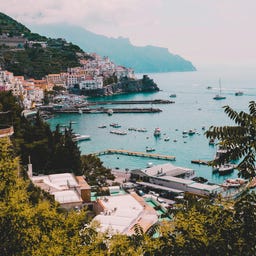
The Amalfi Coast is a spectacular stretch of coastline and is among the most celebrated travel destinations in Italy. Majestic, lush mountains plunge into the azure Tyrrhenian Sea, creating a captivating scene of rugged cliffs and charming houses that boldly perch on the edge.
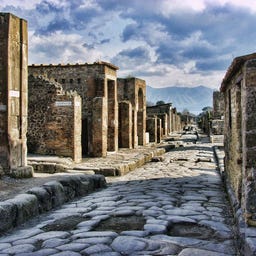
Pompeii is one of the most fascinating ancient cities in the world, offering a unique insight into the life of the ancient Romans. Preserved under a thick layer of ash from the eruption of Mount Vesuvius in 79 AD, a visit to Pompeii feels like a journey through time.
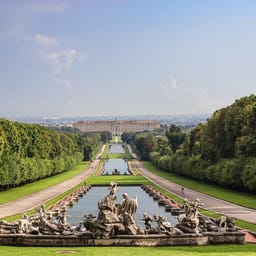
The Royal Palace, a UNESCO World Heritage site, is Italy's monumental homage to the Baroque era and one of the largest palace complexes in Europe. Commissioned by Charles VII of Naples in the 18th century to surpass the grandeur of Versailles, the extravagant palace boasts 1,200 rooms, 1,790 windows, and 34 staircases along its 250-meter-long façade.
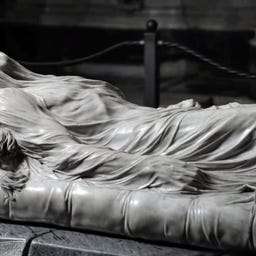
The chapel Sansevero is one of the most impressive masterpieces that you can and should see in Naples. The absolute highlights are the exquisite marble sculptures, such as the Veiled Christ by Giuseppe Sanmartino, which captures the appearance of a translucent shroud in marble with astounding precision.
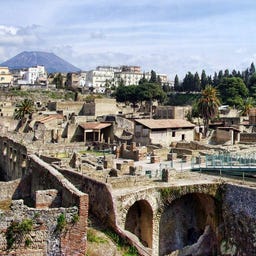
In ancient Herculaneum, which legend says was founded by Hercules in the 12th century BC, you will find one of the best-preserved Roman archaeological sites in the world. The prosperous coastal city was buried by the eruption of Vesuvius in AD 79, with volcanic ash preserving organic materials like wood and food through rapid carbonization.
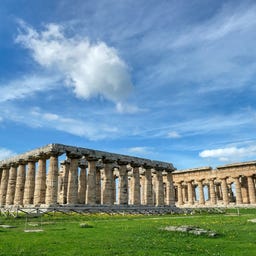
The ancient city of Paestum lies about 100 km south of Naples and is an impressive testament to the Greek colonization of Italy. Founded in 600 BC and taken over by the Romans in 273 BC, Paestum today houses three of the best-preserved Doric temples in the world: the temples of Hera and Athena.
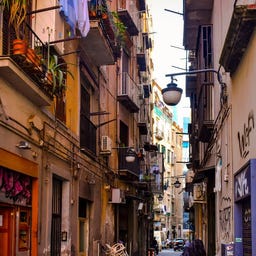
The historic center of Naples is a loud, chaotic maze of alleyways, baroque churches, and historic palaces. The main streets, Spaccanapoli and Via Toledo, are pulsing arteries where you can feel the true life of the city. The streets are filled with the aromas of Neapolitan street food like Pizza Margherita and Sfogliatella, freshly prepared at every corner.
As you dodge the mopeds, marvel at the unique nativity scenes on Via San Gregorio Armeno or buy a Cornicelli, a small red horn that serves as a lucky charm, as a souvenir. Here, you will also find the popular underground catacombs and several remarkable churches.
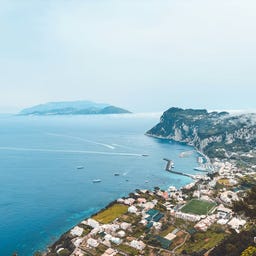
Capri, an island with fantastic panoramas, lies off the Sorrento Peninsula and is a popular destination for day trips. From Villa Jovis, one of Emperor Tiberius' residences, to the Blue Grotto, rediscovered in the 19th century, Capri offers several beautiful attractions.
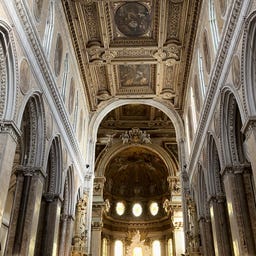
The Duomo di Napoli, also known as the Cattedrale di Santa Maria Assunta, is an outstanding example of Gothic, Baroque, and Neoclassical architecture. One of its highlights is the Royal Chapel of the Treasure of San Gennaro, adorned with exquisite Baroque decorations and frescoes.
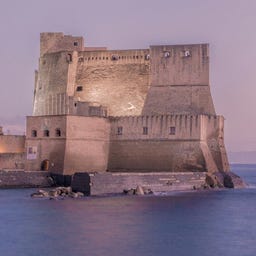
Built in the 12th century by the Normans, Castel dell'Ovo is the oldest fortress in Naples. Legend has it that the poet Virgil hid a magical egg in its foundations to protect the fortress. After destructions and rebuildings under the Angevins and Aragonese, the fortress now hosts events and exhibitions. Located on the small island of Megaride, it offers spectacular views over the Gulf of Naples from its towers and terraces.
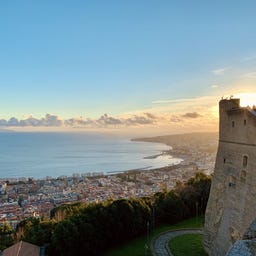
High above Naples on the Vomero Hill stands this impressive fortress from the 14th century. From its walls, one has the most beautiful panoramic views in Naples of Mount Etna, the picturesque bay, and the city. A highlight of any visit!

Napoli Sotterranea offers a fascinating journey into the underground right in the heart of Naples. This popular tour takes you through a labyrinth of ancient aqueducts, Roman tunnels from the 3rd century BC, and WWII air-raid shelters. A highlight is the Greco-Roman theater. Not for the claustrophobic —some passages are really narrow.
The tour lasts about 90 minutes and provides deep insights into the city's history. Tickets can be reserved online, and the meeting point is at Piazza San Gaetano.
Originally laid out by the Greeks, the Romans expanded the network into a complex aqueduct system. During World War II, these passages served as air-raid shelters.
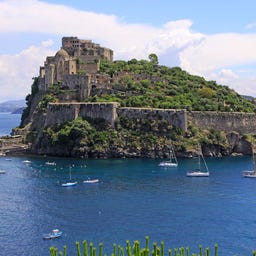
The island of Ischia, the largest jewel of the Phlegraean Islands, is overshadowed by Capri. However, it is well worth a day trip for its lush gardens, healing thermal springs, and picturesque beaches. The beneficial springs, first used by the Greeks and Romans, now draw visitors to luxurious spa facilities for ultimate relaxation.
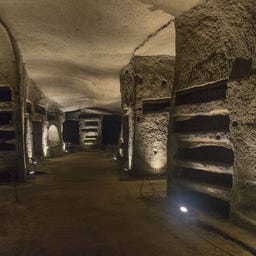
This immense 2-story underground network is located a bit outside of the city centre. The catacombs date back to the 2nd century AD. In the 4th century the expansion of the catacombs began, when the first patron of Naples, Saint Agrippinus, was buried. The lower level includes the Basilica of St. Agrippino, and to this day Mass is celebrated here. In the upper level some of the earliest Christian paintings in the entire south of Italy can be found. The level includes the Crypt of the Bishops, in which the city's bishops were buried and the **basilica
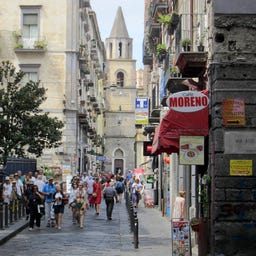
Via dei Tribunali is one of the oldest and most important streets in Naples. Along the street, which served as the main axis of ancient Greek and Roman Neapolis, there are more than twenty historic churches, including the Cathedral of Naples and the Basilica of San Lorenzo Maggiore with its ancient ruins. The path also leads to Napoli Sotterranea, an extensive network of underground tunnels.
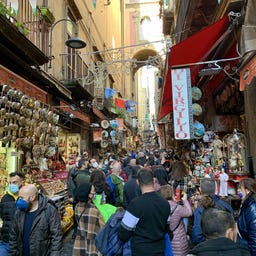
In the narrow Via San Gregorio Armeno, part of the UNESCO World Heritage site in Naples, you will find the most famous nativity scene artisans in Italy. The tradition of these craftsmen dates back to ancient times when small clay figures were offered as sacrifices in the Temple of Ceres.
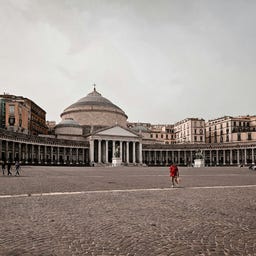
The Piazza del Plebiscito in Naples, one of Italy's largest and most stunning squares, serves as a central meeting point and city symbol. It is flanked by impressive structures, including the neoclassical Basilica di San Francesco di Paola and the Palazzo Reale.
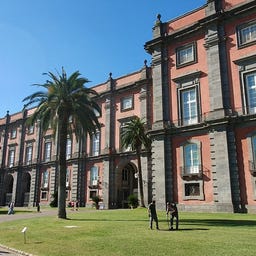
In the magnificent Palazzo Reale di Capodimonte, you will find one of Italy's most important art museums, which has officially been a national museum since 1957. The impressive collection, originally established by King Charles III of Spain for the Farnese collection, now includes masterpieces by Raphael, Titian, and Caravaggio, as well as a unique collection of contemporary art in Italy - featuring Andy Warhol's "Vesuvius."
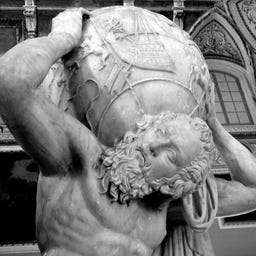
History enthusiasts take note: the museum houses treasures from Pompeii and Herculaneum, making it one of the world's most important archaeological collections. Highlights include the Alexander Mosaic and the Farnese Collection. The Secret Cabinet features ancient erotic art.
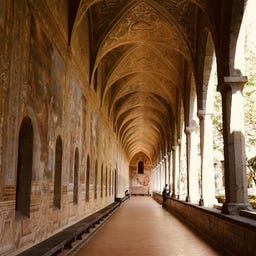
The Monastery Complex of Santa Chiara, renowned for its splendid majolica tiles, ranks among the most popular attractions in Naples. Commissioned by Robert of Anjou in the 14th century for his wife Sancia of Majorca, the basilica was meticulously reconstructed after the devastating destruction of World War II. Particularly noteworthy are the 17th-century cloisters adorned with colorful majolica tiles and frescoes on 72 columns, enhancing the peaceful monastery garden.
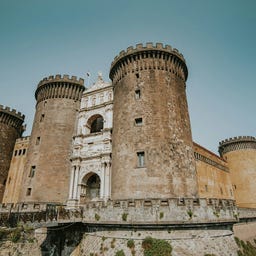
The impressive Castel Nuovo, also known as Maschio Angioino, has been overlooking the Piazza Municipio since the 13th century and is one of the most iconic landmarks of Naples. This fortress, flanked by five round towers, combines Gothic and Renaissance elements and now houses the city museum, featuring the remarkable Palatine Chapel.
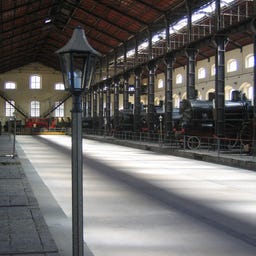
In the historic workshops of the former Royal Bourbon Workshops from the 19th century, you can today explore one of the most significant railway museums in Italy. Located right on the beach in Naples, the museum spans seven pavilions covering a total area of 36,000 square meters and presents you with the history of the Italian railway.
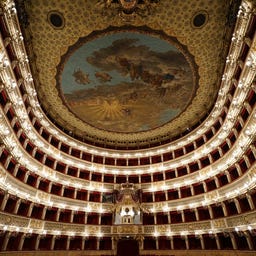
The neoclassical Teatro San Carlo, opened in 1737, is the oldest opera house in the world still in operation - it is decades older than Milan's La Scala. Originally built by King Charles III of Bourbon, the theater impresses guests with its outstanding acoustics and opulent interior, featuring golden decorations and blue upholstery—the colors of the House of Bourbon.
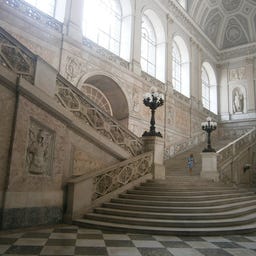
Built in the 17th century, the Royal Palace originally served as a residence for Spanish viceroys. Later, it became the seat of the Bourbon monarchs, who transformed Naples into a cultural center of Europe. Notable visitors included Napoleon Bonaparte and King Ferdinand II, as well as Goethe and Mozart.
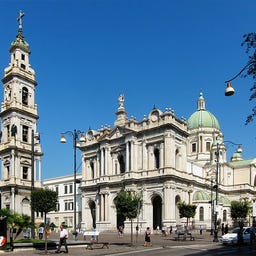
The magnificent Basilica of the Madonna of Pompeii is one of the most visited Marian shrines in Italy, attracting over four million pilgrims and visitors each year. This impressive sacred building, initiated by Bartolo Longo in 1876, owes its existence to donations from believers around the world and was elevated to a papal basilica by Pope Leo XIII. in 1901.
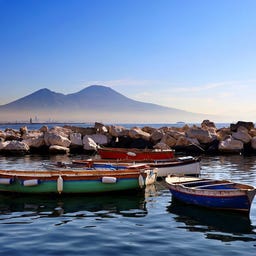
Mount Vesuvius, an active stratovolcano, majestically towers over the Gulf of Naples. Famous for its catastrophic eruption in 79 AD that buried Pompeii and Herculaneum under ash and lava, it now draws countless visitors.
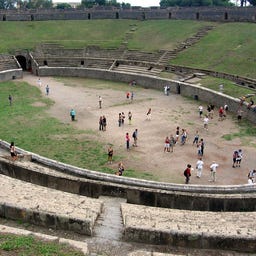
As one of the oldest and best-preserved amphitheaters in the Roman world, the impressive structure from the 1st century BC stands in the southeast of ancient Pompeii. Built by Gaius Quinctius Valgus and Marcus Porcius, this oval arena could accommodate up to 20,000 spectators who came to watch gladiator fights and circus games.
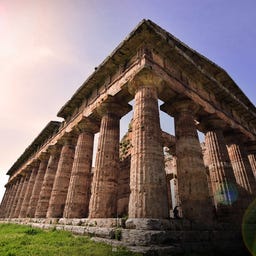
The Temple of Neptune is one of the best-preserved Greek temples from antiquity and has dominated the skyline of Poseidonia, now Paestum, since the mid-5th century BC.
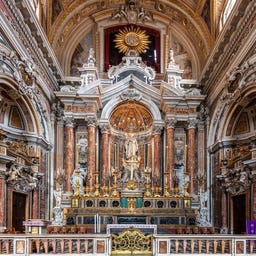
The facade of this unassuming church features small pointy pyramids, a style popular in the Venetian Renaissance. Inside the church houses one of the most beautiful interiors in Naples.
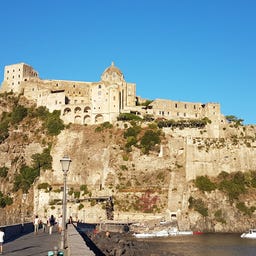
Majestically, the Castello Aragonese stands on a 113-meter-high rocky island off the coast of Ischia, connected to the historic village of Celsa by a 220-meter-long stone bridge. The fortress's history dates back to 474 BC when the Greek tyrant Hiero I of Syracuse built the first castle here.
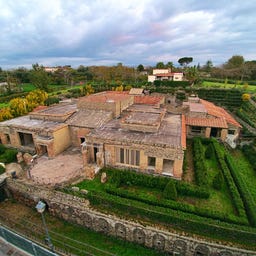
Right outside the gates of ancient Pompeii, you will find the Villa dei Misteri, a magnificent Roman villa from the 2nd century BC that was buried during the eruption of Vesuvius in AD 79. The well-preserved frescoes in the villa's dining room are among the most significant wall paintings of Roman antiquity and likely depict a wedding ritual in honor of the god Dionysus in life-sized representations.
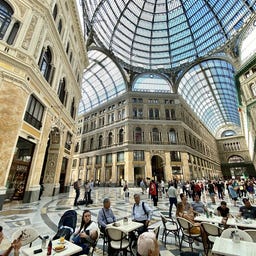
The Galleria Umberto I in Naples, built between 1887 and 1890, is an architectural masterpiece of the 19th century. Its cross-shaped structure, featuring a glass dome supported by 16 metal ribs, captivates with elegant mosaics and intricate sculptures. Originally designed as part of urban renewal, the Galleria now hosts a mix of shops, cafés, and offices, remaining a vibrant hub of Neapolitan life.
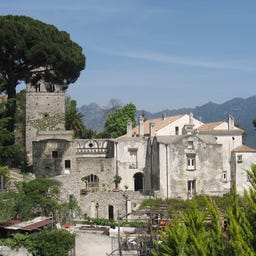
This popular day trip destination near Piazza Vescovado in Ravello, excudes abundant Mediterranean charm. Commissioned by the affluent Rufolo dynasty in the 13th century, this villa is a harmonious blend of Arab, Sicilian, and Norman architectural styles.
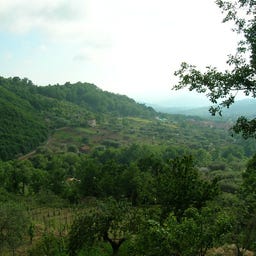
In southern Italy's Cilento, you will find an impressive mountainous region with 130 kilometers of coastline, which has been a UNESCO World Heritage site since 1998. This historically rich area, named after the Latin "cis-Alentum" (this side of the Alento River), has been shaped over the centuries by the Lombards, Normans, and Byzantines, and was the scene of Ottoman pirate raids from the 15th to the 17th century.
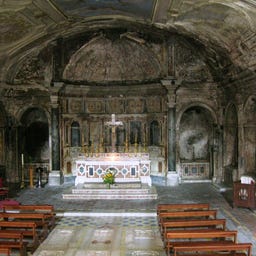
In the Catacombs of San Gaudioso, one of the oldest early Christian burial sites in Naples from the 4th-5th centuries, you can expect a fascinating journey beneath the streets of the Stella district. The entrance to this historic site is located in the crypt of the Madonna della Sanità church, where impressive frescoes from various periods and a 6th-century mosaic at the tomb of San Gaudioso await you.

Originally built in 1853 as a secret escape route for the king and his family, the tunnel stretches about 500 meters, connecting the royal palace to the sea. During World War II, it sheltered thousands of Neapolitans from bombings. Today, the tunnel, filled with antique vehicles, statues, and impressive architectural details, offers a fascinating glimpse into history and is a must-see for every visitor.
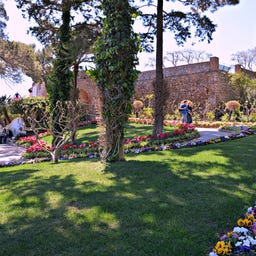
The Giardini di Augusto offer you one of the most impressive panoramic views of Capri, overlooking the Marina Piccola and the famous Faraglioni rocks. Originally, the gardens were created in the early 20th century by the German steel industrialist Friedrich Alfred Krupp, before being renamed in 1918 in honor of the first Roman emperor.

The "Veiled Christ" in the Cappella Sansevero in Naples is a breathtaking masterpiece by sculptor Giuseppe Sanmartino from 1753. This marble statue portrays the dead Christ draped in a delicate veil, so finely detailed it appears like real fabric. The intricate depiction of Christ's facial features and the signs of the Passion beneath the veil bring both pain and beauty vividly to life. Attracting visitors from around the world, this extraordinary artwork is enveloped in myths about its creation and the alchemical secrets of its patron, Raimondo di Sangro.
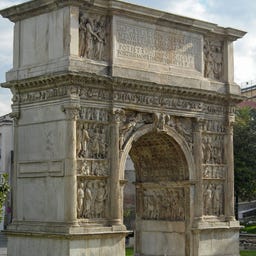
The Arco di Traiano in Benevento is one of the best-preserved Roman triumphal arches in the world and has been impressing visitors since the 2nd century with its richly decorated façade and numerous reliefs. Built in honor of Emperor Trajan between 114 and 117 AD, the arch not only survived the Gothic Wars but also served later as the city gate "Porta Aurea" and was only cleared in 1850 on the orders of Pope Pius IX.
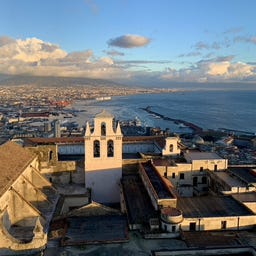
High above Naples stands the Certosa di San Martino, one of the largest religious complexes in the city, which has shaped the Vomero hill since 1325. In the approximately 100 rooms, two churches, and three cloisters, you will find the National Museum San Martino, which tells the cultural history of Naples from the Baroque period to modern times.
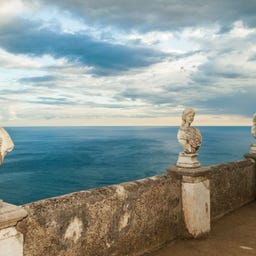
The Terrazza dell’Infinito, or Terrace of Infinity, is famous for its breathtaking views, where the azure sky meets the vast expanse of the sea. Perched more than 365 meters above the Mediterranean, it creates the illusion of an endless sea stretching to the horizon.
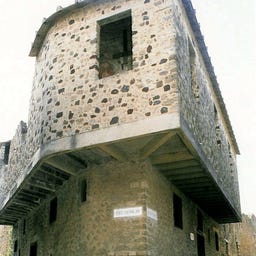
The Lupanare in Pompeii is one of the best-preserved brothels of the ancient Roman world and offers an authentic glimpse into this normalized part of society at the time. In the simple rooms with stone beds and erotic wall paintings, prostitutes offered their services while the operators Victor and Africanus ran the business.
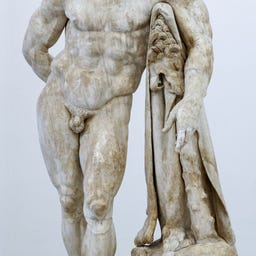
At the Archaeological National Museum of Naples, you can admire one of the most famous ancient marble sculptures in the world, the "Hercules Farnese." This impressive 3.17-meter tall statue was created by Glykon of Athens and depicts Hercules resting on his club, exhausted after completing his labors, while holding the golden apples of the Hesperides.
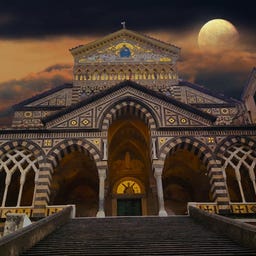
The Cathedral rises proudly above the Piazza del Duomo in Amalfi. Begun in the 9th century and remodeled several times, it combines Arab-Norman, Gothic, Renaissance, and Baroque elements. It is particularly famous for its Norman-Arab-Byzantine facade from the 19th century and the magnificent bronze doors from Constantinople.
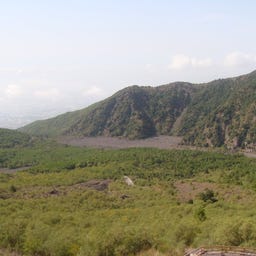
In the Vesuvius National Park, you will find the only active volcano on the European mainland, which has shaped the region around Naples with its dramatic history. Established in 1995, the national park not only protects the famous Vesuvius and the extinct Monte Somma, but also an astonishingly diverse ecosystem with over 600 plant and 227 animal species.
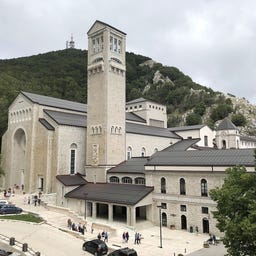
High above the Campanian landscape stands the Santuario di Montevergine, one of the most important Marian shrines in Italy, attracting 1.5 million pilgrims each year. Founded in the 11th century by Guglielmo da Vercelli, the sanctuary houses the revered painting of the Madonna of Montevergine and served as a secret storage place for the Shroud of Turin during World War II.
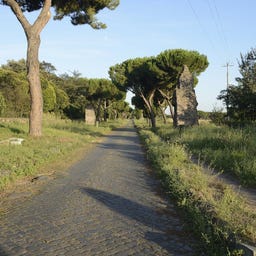
The Via Appia, reverently called "Regina Viarum" (Queen of Roads) by the Romans, is one of the most important routes of antiquity, connecting Rome to the port town of Brindisi over 650 kilometers. Started in 312 BC by Appius Claudius Caecus, this road is considered a technical masterpiece of the ancient world and was continuously expanded by various Roman emperors like Augustus and Trajan. The first section near Rome is particularly well-preserved today, inviting you to explore archaeological sites among centuries-old monuments and excavations. Since 2024, the Via Appia has been part of the UNESCO World Heritage and is protected by a regional park that preserves its historical significance.
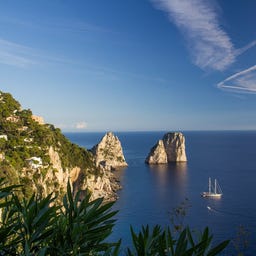
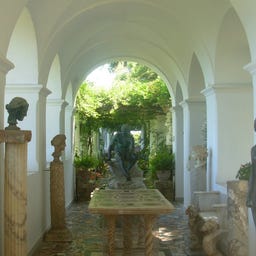
On the ruins of an ancient Roman villa of Emperor Tiberius stands today one of the most visited buildings in Capri: the Villa San Michele in Anacapri. The Swedish doctor Axel Munthe fell in love with the place at the end of the 19th century, bought the property, and created a fascinating museum complex on several levels that combines Renaissance furniture, Roman artifacts, and an Egyptian sphinx from the time of Ramses II.
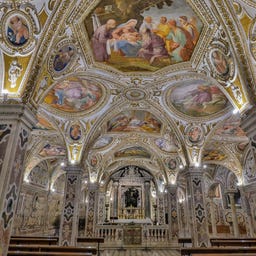
The Cattedrale di Salerno, also known as San Matteo, is one of the most significant sacred buildings in southern Italy, serving as the final resting place of the Apostle Matthew. The true highlight is the magnificently designed, Baroque-style crypt from the 17th century, where his tomb is located.
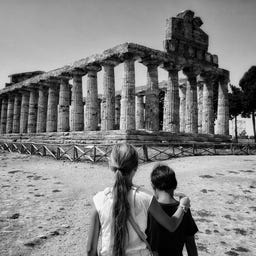
In the Archaeological Park of Paestum, you will find the Temple of Athena, an impressive temple from the 6th century BC that combines both Doric and Ionic architectural elements. Built on an artificial elevation, this structure captivates with its balanced proportions, featuring 6 front columns and 13 side columns, making it one of the earliest examples of the combination of these two column styles. Originally dedicated to the goddess Ceres, the temple was later attributed to Athena and transformed into a church in the 8th century. Excavations in 1937 uncovered terracotta fragments that provided important insights into the original roof structure.
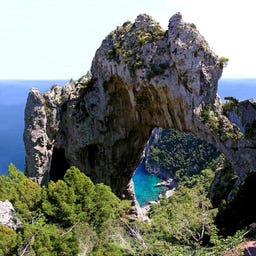
The majestic Arco Naturale is a natural limestone arch on the island of Capri, rising 18 meters high and spanning 12 meters wide. This impressive rock formation was created during the Paleolithic era when a large underground cave partially collapsed due to erosion and landslides.
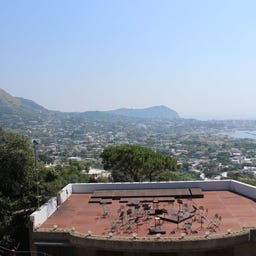
In the terraced Giardini La Mortella on Ischia, you can discover over 3,000 exotic plant species, spread across two distinct areas: a shady valley section and a sunny upper area with views of the Forio Bay.
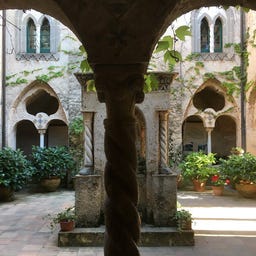
The historic 11th-century villa offers one of the most stunning views of the Amalfi Coast from its famous Terrazza dell'Infinito. Redesigned by Lord Grimthorpe in the early 20th century, the gardens blend Renaissance and English landscape design with exotic plants and romantic pavilions. Today, the villa is a 5-star luxury hotel, and its enchanting gardens, adorned with ancient statues and pergolas, are open to the public.
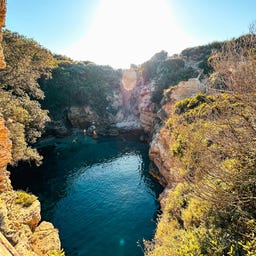
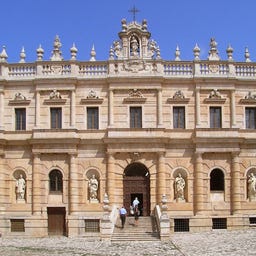
In the picturesque region of Vallo di Diano, you will find the Certosa di San Lorenzo, the largest Carthusian monastery in Italy, which has been a UNESCO World Heritage site since 1998. This impressive complex, founded in 1306 by Tommaso II Sanseverino, spans 51,500 square meters and was magnificently redesigned in Baroque style between the 16th and 18th centuries.
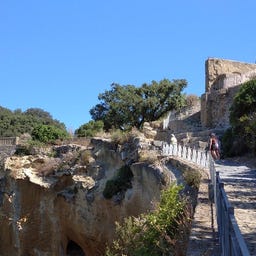
In the ancient ruins of Scavi Archeologici di Cuma, you explore one of the oldest Greek colonies in Italy, founded around 750 BC, which played a significant role in spreading Greek culture. The extensive excavation site in the volcanic Campi Flegrei is home to the famous Antro della Sibilla, the mysterious cave where, according to legend, the Sibyl's oracle foretold the future - known from Virgil's "Aeneid."
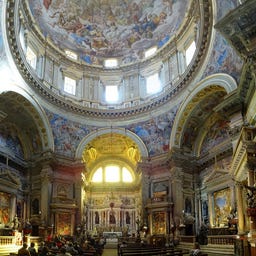
In the magnificent Baroque chapel Reale cappella del tesoro di San Gennaro in the Duomo di Napoli, you encounter one of the artistic highlights of Naples from the 17th century. Built between 1608 and 1646, the chapel was created as a result of a vow made by the city's inhabitants during a time of wars, plagues, and volcanic eruptions.
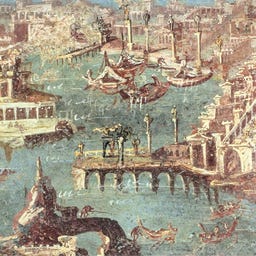
In the ancient Roman villas of Stabiae, you will find the largest collection of well-preserved coastal villas in the Roman world. This luxurious residential complex, buried under ash during the eruption of Vesuvius in 79 AD, was a popular retreat for wealthy Romans, offering spectacular views of the Bay of Naples.
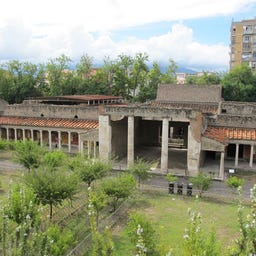
When you visit the ancient villa complex of Oplontis, you immerse yourself in one of the best-preserved Roman archaeological sites on the Bay of Naples. The settlement was buried under ash during the eruption of Vesuvius in 79 AD, just like Pompeii and Herculaneum, and has been a UNESCO World Heritage Site since 1997.
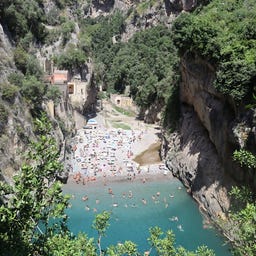
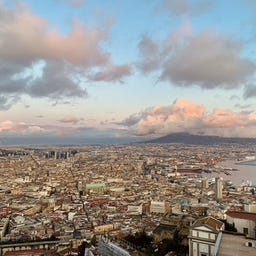
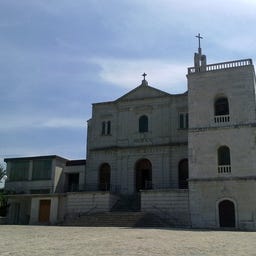
In the small village of Materdomini stands the Santuario di san Gerardo Maiella, an important pilgrimage site that has its origins in a medieval apparition of Mary. Since the early 16th century, believers from Irpinia, Lucania, and the Salernitano have flocked to this sanctuary, which was elevated to a minor basilica by Pope Pius XI in 1930.
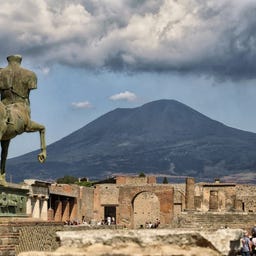
In the heart of ancient Pompeii, you will find the Foro di Pompei, one of the best-preserved marketplaces of Roman Italy. This impressive square, 143 meters long, was originally established in the 4th century BC and became the political, economic, and religious center of the city.
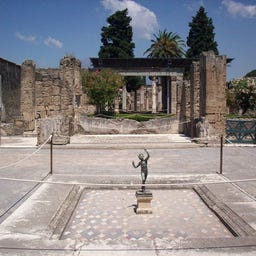
In the Casa del Fauno, one of the largest residences in ancient Pompeii, you will find an impressive example of Roman-Hellenistic architecture from the 2nd century BC. Named after a bronze statue of a dancing satyr, the villa features expansive colonnaded courtyards with a total of 72 Ionic and Doric columns, as well as a magnificent atrium with a travertine water basin.
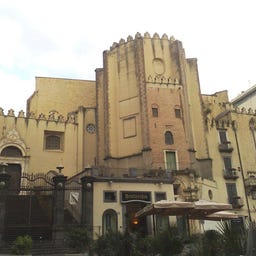
In the monumental Chiesa di San Domenico Maggiore, dating back to the late 13th century, you encounter one of Naples' most significant churches, built by Charles II of Anjou between 1283 and 1324. The Gothic basilica impresses with its three naves, 27 ornate chapels, and magnificent frescoes by Pietro Cavallini, while the baroque coffered ceiling from the 17th century provides an intriguing contrast to the medieval architecture.
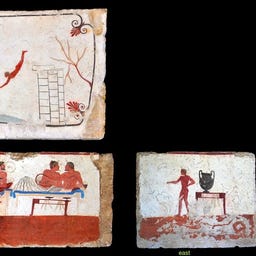
In the Tomb of the Diver, you will find one of the most significant examples of ancient funerary painting from the early 5th century BC. Discovered in 1968 by Mario Napoli near Paestum, this burial chamber consists of five intricately painted limestone slabs that offer unique insights into the culture of Greater Greece.
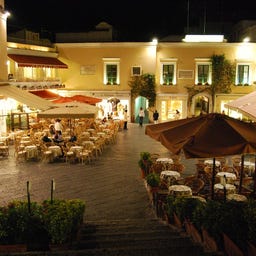
The square lovingly called "Piazzetta" by the locals, Piazza Umberto I, is the vibrant heart of Capri and has transformed from an ancient defense post to the island's current meeting point. The perfectly square plaza, which you can walk around in about a minute, took on its characteristic shape in the 16th century and has been used over the centuries as a marketplace, festival ground, and site for religious processions.

In ancient Pompeii, you can find the impressive Teatro Grande, a Roman theater from the 2nd century BC that accommodated up to 5,000 spectators and was buried during the eruption of Vesuvius in AD 79.
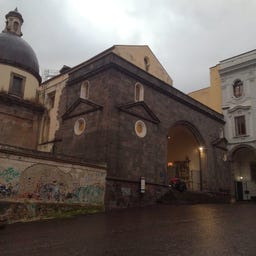
In the monumental Chiesa di Sant'Anna dei Lombardi, you will find an impressive blend of Renaissance and Baroque architecture right in the heart of Naples. Founded in 1411 by Gorello Origlia, the church was redesigned in the 17th century by Gaetano Sacco and houses significant Renaissance artworks, including masterpieces by Benedetto da Maiano and Antonio Rossellino.
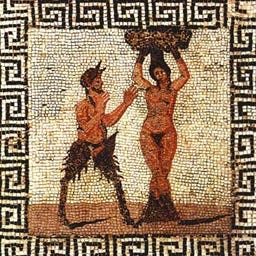
At the National Archaeological Museum of Naples, you will find the Gabinetto Segreto, an extraordinary collection of erotic artworks and everyday objects from antiquity. This controversial collection was established by the Bourbon kings and was long accessible only to select visitors; at times, it was even walled up until Garibaldi made it available to the public in 1860.
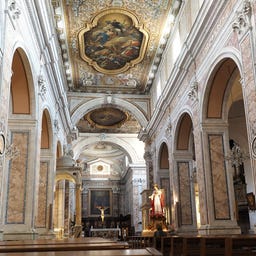
The impressive Cattedrale dei Santi Filippo e Giacomo has a rich history that dates back to the 11th century and is built on the remains of a Greek temple. In its current form, the cathedral features a neo-Gothic facade from 1924 and a magnificent Baroque interior from the early 18th century, divided into three naves by fourteen columns.
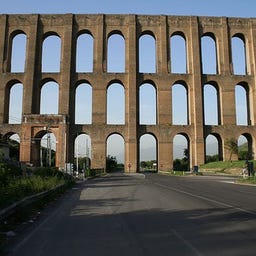
The Acquedotto Carolino, also known as the Acquedotto di Vanvitelli, is an impressive water supply system from the 18th century that still provides water to the Royal Palace of Caserta today. Designed by Luigi Vanvitelli, this structure stretches over 38 kilometers and is considered one of the most significant engineering achievements of its time.
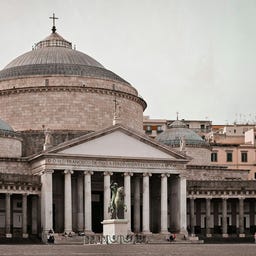
The majestic Basilica di San Francesco di Paola dominates the Piazza del Plebiscito in the historic center of Naples and is one of the most significant examples of neoclassical architecture in Italy.
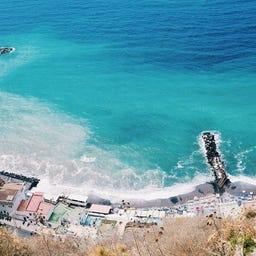
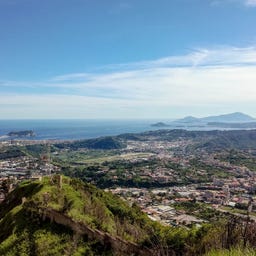
West of Naples, you will find one of the most fascinating volcanic landscapes in Europe: the Campi Flegrei. This massive crater, measuring 15-18 km in diameter, has been active for over 80,000 years.
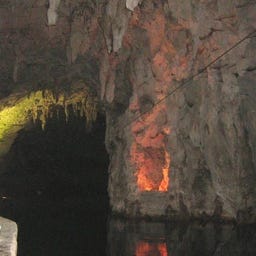
In the Grotte di Pertosa-Auletta, one of the few non-marine cave systems with a navigable river, you will discover a fascinating underground world with an underground lake. Since their scientific exploration by Paolo Carucci in the late 19th century and their opening to tourism in 1932, the stalactite caves attract over 50,000 visitors each year.
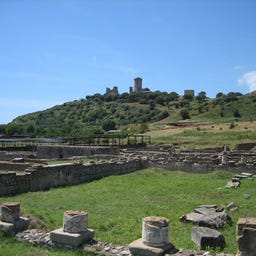
In the gentle hills of the Cilento National Park, you will find Elea-Velia, one of the most significant archaeological sites in Southern Italy, which has been a UNESCO World Heritage Site since 1998. Founded in the 6th century BC by fleeing Phocaeans, the city developed into an important trading center and became particularly known for the Eleatic school of philosophy established by Parmenides. Today, you can still experience the different eras of the city, from its Greek foundation to the Roman period, among ancient baths, the impressive Porta Rosa, and the Acropolis. The well-preserved remains of the harbor district, the Agora, and the southern quarter provide you with an authentic insight into the life of this once-thriving Mediterranean metropolis.
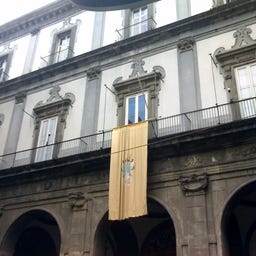
In the heart of Naples, you'll find the Pio Monte della Misericordia, an impressive blend of church, museum, and charitable institution from the early 17th century. The octagonal church houses one of the most significant works of Italian Baroque painting, Caravaggio's famous painting "The Seven Works of Mercy."
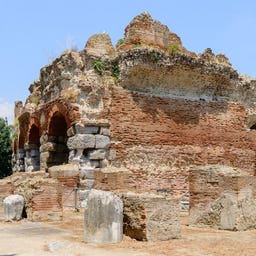
Only surpassed in size by the Colosseum in Rome and the amphitheater of Capua, you will find in Pozzuoli one of the best-preserved Roman amphitheaters from the 1st century. The Anfiteatro Flavio, built by the same architects as the Colosseum, once accommodated up to 40,000 spectators and was likely inaugurated by Emperor Titus.
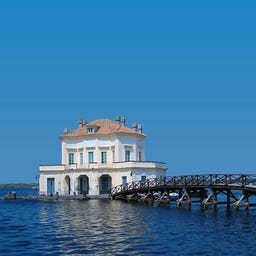
On a small island in Lago Fusaro, the elegant Casina Vanvitelliana rises, a royal hunting lodge from the 18th century with its distinctive octagonal shape. Completed by Carlo Vanvitelli in 1782, this building served the Bourbons as an exclusive retreat for hunting and fishing, hosting illustrious guests like Francesco II d'Asburgo-Lorena and the composer Gioachino Rossini.

In the historic center of Naples, you'll find the Palazzo dello Spagnolo, an impressive example of Neapolitan Baroque architecture from the 18th century. Built in 1738 for Marquis Nicola Moscati, the city palace got its name from the Spanish nobleman Tommaso Atienza, who later expanded and artistically enhanced the building.
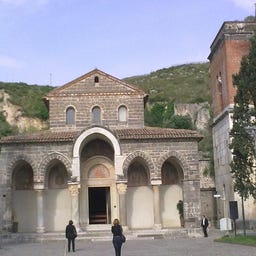
Perched on the remains of an ancient temple dedicated to Diana, the Abbazia di Sant'Angelo in Formis is one of the most significant church buildings in Campania. Originally built in the 6th century and redesigned between 1072 and 1087 by Abbot Desiderio of Montecassino, the basilica captivates with its distinctive porch featuring five pointed arches on Roman columns.
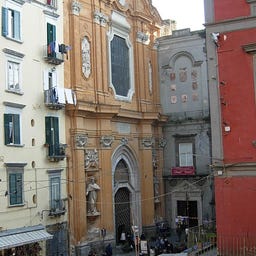
The Basilica di San Lorenzo Maggiore is one of the oldest monumental churches in Naples, blending French Gothic with Baroque elements into a unique ensemble. Beneath the church, built in the 13th century, you can discover fascinating archaeological excavations that date back to the 4th century BC, revealing remnants of the Greek and Roman marketplace.
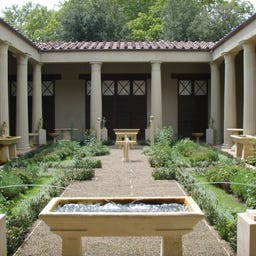
In the Casa dei Vettii, one of the best-preserved houses in Pompeii, you can expect a fascinating glimpse into the life of a wealthy Roman family from the 1st century AD. The property, acquired by the freedman family of the Vettii, was buried during the eruption of Vesuvius in 79 AD and was only rediscovered in 1894.
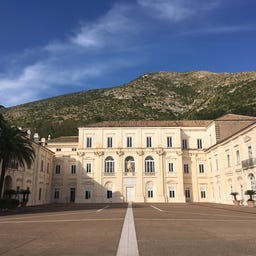
In the picturesque Caserta, the Belvedere di San Leucio awaits you, a fascinating testament to social innovation from the 18th century that is now a UNESCO World Heritage site. The complex, initiated by King Charles of Bourbon, was designed as an autonomous workers' town where residents lived under progressive social laws and worked in the world-renowned silk production—luxurious fabrics that later adorned the White House and Buckingham Palace.

In the magnificent Basilica del Carmine Maggiore, you will find one of the most fascinating churches in Naples, with a history that dates back to the 13th century. This church, designed in the Neapolitan Baroque style, houses the famous miraculous crucifix, which, according to legend, bowed its head in 1439 to avoid a cannonball.

High above the Gulf of Naples awaits you the Parco Virgiliano, a panoramic park covering 92,000 square meters in the Posillipo district. From its terraced viewpoints at a height of 150 meters, you can enjoy breathtaking views of the islands of Procida, Ischia, and Capri, the historic center of Naples, and Mount Vesuvius.
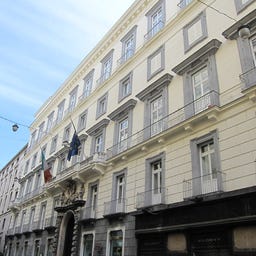
The Palazzo Zevallos on the bustling Via Toledo was built between 1637 and 1639 by Cosimo Fanzago for the nobleman Juan de Ceballos and today stands as an impressive example of Naples' architectural development from the 17th to the 19th century.

At the Museo del tesoro di San Gennaro, you will find one of the most valuable collections of religious art treasures in Italy, gathered since the 14th century. Over 700 square meters, you can admire magnificent jewels, including a mitre adorned with 3,694 gemstones from 1713 and a necklace that has been continuously expanded for over 250 years in honor of Saint Januarius.
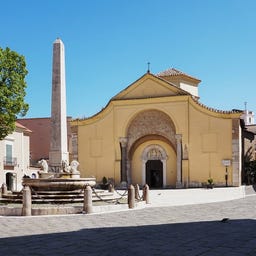
In the Church of Santa Sofia in Benevento, you encounter one of the most significant examples of Lombard architecture in Southern Italy, which has been a UNESCO World Heritage Site since 2011. Founded around 758 by Duke Arechi II, this sacred building captivates with its unique hexagonal layout, inspired by the Hagia Sophia in Constantinople.
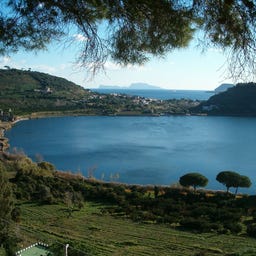
In an extinct volcanic crater of the Campi Flegrei lies Lake Averno, the second largest lake in this volcanic region west of Naples. Formed about 4,000 years ago, this crater lake was considered in ancient times as the entrance to the underworld and played an important role in Virgil's Aeneid.
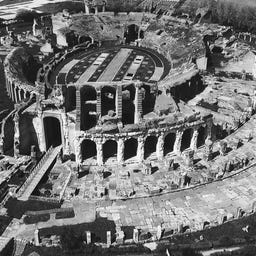
As the second-largest amphitheater of the ancient world after the Colosseum, the Anfiteatro campano still impresses today with its massive dimensions of 170 x 139 meters. At this historic site in Santa Maria Capua Vetere once stood the gladiator school where Spartacus began his legendary uprising in 73 BC.
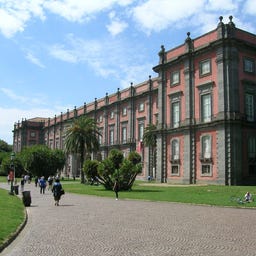
High above Naples stands the Reggia di Capodimonte, an impressive Baroque palace that Charles III of Bourbon had built in 1738 as a royal residence and museum for the Farnese collection.
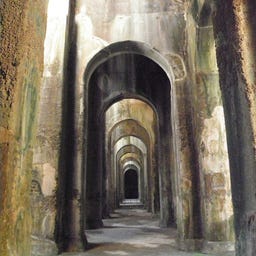
In the ancient port city of Bacoli near Naples, you will find the Piscina Mirabilis, the second-largest Roman cistern in the world. This impressive water reservoir was carved from tuff stone during the time of Augustus and once supplied fresh water to the Roman navy, which was brought in through a 100-kilometer-long aqueduct from Serino.
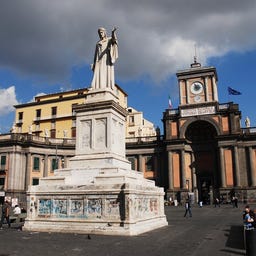
Piazza Dante in the historic center of Naples is one of the city's most important squares and marks the beginning of the bustling Via Toledo. Originally established as a marketplace in the 16th century, it took on its current form through Luigi Vanvitelli's impressive redesign in the late 18th century, with the centerpiece being the semi-circular Foro Carolino, adorned with 26 statues representing royal virtues.
